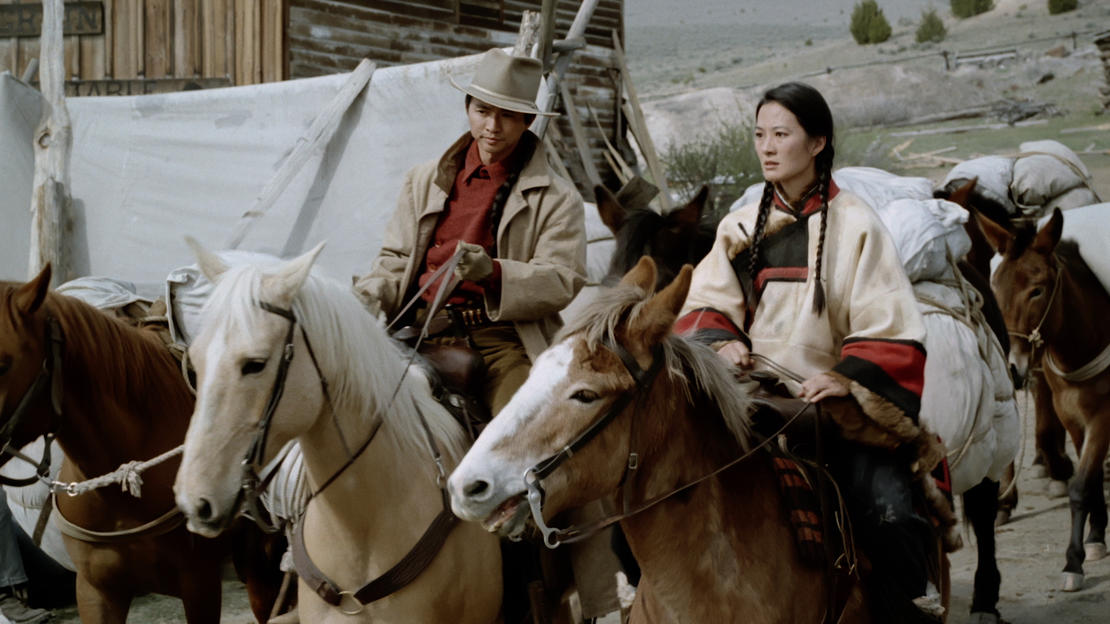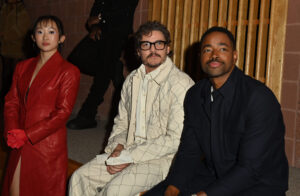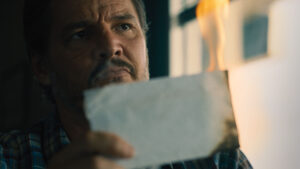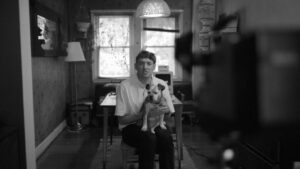Rosalind Chao stars as Lalu in Nancy Kelly’s 1991 film ‘Thousand Pieces of Gold.’
Virginia Yapp
When Thousand Pieces of Gold hit theaters in 1991, critics were quick to compare first-time feature director Nancy Kelly to filmmakers like John Ford, Budd Boetticher, and George Stevens, masters of the classic Western—and that was something Kelly and her filmmaking partner (and husband), Kenji Yamamoto, weren’t sure how to take at the time.
“We just don’t like Westerns that much,” Yamamoto told me over the phone when I caught up with the pair to find out more about the making of the project, which went through the Sundance Institute Screenwriters Lab in 1989, premiered at the San Francisco International Film Festival in 1991, and was recently given a 4K restoration by IndieCollect that is being released by Kino Lorber.
Not that they wrote the genre off altogether: “My favorites feature powerful leading women: Destry Rides Again, Johnny Guitar, The Big Country, The Outlaw,” Kelly wrote in a recent piece for IndieWire. Set in Idaho and shot in Montana, Thousand Pieces of Gold features gorgeously photographed mountain vistas, old-time saloons, and horseback riding, but there’s a lot more going on under the surface.
The film, which is now screening in virtual independent cinemas through June, is a Western, but it’s also an immigrant story and a tale of a courageous young woman asserting her independence. A true story based on the life of a young Chinese woman who was sold into slavery by her father and brought to the American West after the Civil War, it also centers around an interracial romance and delves into the effects of PTSD on veterans.
In effect, Kelly and her collaborators offer up a new lens on American history, telling an important story that’s been left out of textbooks and John Wayne shoot-’em-ups. “To us, it was just this story of a Chinese woman’s empowerment—her fight against racism, and also [a] love story,” Kelly explains of the film, which stars Rosalind Chao and Chris Cooper.
As you might imagine, making Thousand Pieces of Gold in the ’80s wasn’t easy: for one, there weren’t too many female directors helming narrative features in Hollywood at the time, and executives weren’t very receptive to the idea of financing a film without a white male lead. So how did this film get made? I chatted with Kelly, Yamamoto, and screenwriter Anne Makepeace to find out the full story.
From Coast to Coast

Kenji Yamamoto and Nancy Kelly on the set of ‘Thousand Pieces of Gold.’
“When I met Nancy, she was a cowgirl who worked on a ranch,” Yamamoto says. Though Kelly had been raised in a working-class town in Massachusetts, she was always fascinated by horses. So when Gwendolyn Clancy, a friend she had met at her first film job, convinced her to come work with her on a cattle ranch in Modoc County, California, she jumped at the chance.
“I quit my job!” says Kelly. “I went out there and she taught me how to ride, and we lived there for three years. I trained my own horse; I learned to rope.”
When I met Nancy, she was a cowgirl who worked on a ranch.
—Kenji Yamamoto
Kelly continued making films while working on the ranch—but editing on site was a bit tricky. “It was impossible,” she says. “You’d be working and you’d look out the window and the cattle would have broken through the fence and gotten out on the highway, and you’d spend the whole day fixing the fence,” she recalls.
So to finish her documentary short A Cowhand’s Song, she and Clancy headed to San Francisco, where they met Yamamoto.
“Nancy needed an editor, and someone referred me and a few others, and we amused each other,” adds Yamamoto, who had studied painting and experimental film at the San Francisco Art Institute. “We’re married and have been working partners for that long, if you can believe it. We’ve worked on eight projects together.”
Finding ‘Thousand Pieces of Gold’

An 1894 photo of Lalu Nathoy, whose life was the basis for ‘Thousand Pieces of Gold.’ | Public Domain
While working as documentary filmmakers in the early ’80s, Yamamoto and Kelly began attending the fledgling Utah/U.S. Film Festival (later renamed the Sundance Film Festival) in Park City, Utah. “It was only at the Egyptian [Theatre],,” Kelly recalls. “The closing-night party was just, like, this little dinner. … I mean, it really was tiny.”
At the 1985 festival, Kelly’s short film Cowgirls was picked up for distribution by Mitchell Block, president of Direct Cinema Limited. Block would prove to be an important connection—as would writer Anne Makepeace, who Kelly had met at an earlier festival in New York.
Kelly and Yamamoto’s next project was an adaptation of Ruthanne Lum McCunn’s best-selling novel Thousand Pieces of Gold. It was based on the true story of Lalu Nathoy (Rosalind Chao), a woman born in northern China in 1853 who was sold by her father to a pair of bandits, smuggled into the United States around 1872, and enslaved in San Francisco before being relocated to Idaho. Eventually, Nathoy won her freedom and married a white saloon owner, Charlie Bemis; the pair lived along the Salmon River, where Nathoy died in 1933 at the age of 80.
It was a compelling story to Kelly, who had stumbled upon the novel at an independent bookstore in the early ’80s while touring with one of her shorts, and after she was finally able to secure the rights (a “big-time Hollywood producer” had originally been working on an adaptation), she and Yamamoto brought Makepeace on to turn the novel into a script.
Ironing Out the Story at the Sundance Institute Labs
Nancy Kelly and Anne Makepeace at the 1987 Screenwriters Lab. ©1987 Sundance Institute | Photo by Roger Christiansen
Kelly, Makepeace, and Yamamoto were invited to bring Thousand Pieces of Gold to the Screenwriters Lab at the Sundance Resort in the summer of 1987, where they worked on the script with seasoned advisors including screenwriters Frank Pierson (Dog Day Afternoon, Cool Hand Luke), Judith Rascoe (Endless Love, Who’ll Stop the Rain), and Tom Rickman (Coal Miner’s Daughter, Tuesdays with Morrie).
“Being at Sundance was heaven,” says Makepeace, who had gone through the labs a few years earlier with a feature called Jewels. “We were in a beautiful place where we could focus exclusively on the script, with the full attention of inspiring, highly accomplished writers. The draft I wrote right after Sundance included many of their brilliant ideas. That was the draft that brought in [the PBS program] American Playhouse. We were on our way.”
The experience was also critical for other reasons, Kelly says: “Now, independent film is a force, but at that time, we might as well have been experimental poets! We really didn’t carry any cred anywhere that we went, but [at the labs] it was like people recognized what we were. And really, I took that away. I still rest on that.”
Makepeace made a number of critical tweaks to the original story, Kelly explains: “[She] gave Charlie a lot of contradictions. … Even though he was a veteran of the Civil War, he wasn’t a revolutionary. In a Q&A we just did, there was this moment when Chris [Cooper] said, ‘Can you imagine Charlie standing up to that whole town about slavery? He would have been run out of that town on a rail.’”
Rounding Up the Financing
After the labs, with the support of American Playhouse, Kelly and Yamamoto hit the ground in search of financing—a process that would take them a few years as they contended with the prejudices of studio executives in the late ’80s. They ultimately decided to produce the film themselves.
“When we would both be at meetings, we stood out as the Japanese American producer and the very short female director/producer,” Yamamoto says. “Often when the discussion would go forward, they would look to me for all the directorial questions and not look at Nancy, and that was the indication that we weren’t in the right place. … That’s what we were faced with.”
When we would both be at meetings, we stood out as the Japanese American producer and the very short female director/producer.
—Kenji Yamamoto
On another occasion, Kelly went to LA by herself for meetings they had set up with producers. “One of them was just like, ‘How much nudity is there going to be?’ And another guy at a distribution company we worshipped … said, ‘This is girl-meets-boy. That’s the trouble with it. If it was boy-meets-girl, I could see it.’ I was so mad! I mean, I’m kind of known for my temper, but I just kind of grabbed my stuff and marched to the elevator.”
There was a silver lining to that particular trip, however. On her drive up to San Francisco, she stopped at Mitchell Block’s house to pick up a royalty check for an earlier project. When she arrived, Block was chatting with Sidney Kantor, who ran a company called Maverick Films with his partner, John Sham, in Hong Kong.
“I gave Sidney a copy of the script,” Kelly says. “That was a Friday, and that Monday, he called and said, ‘We want to bring you to Hong Kong to meet John and make a deal.’ Two weeks after that, we were in Hong Kong!”
Casting Their Two Leads

Chris Cooper and Rosalind Chao star in Nancy Kelly’s ‘Thousand Pieces of Gold.’ | Kino Lorber
Next, they tapped casting director Lora Kennedy—who Kelly had been introduced to by Sundance Institute’s Michelle Satter—to find their two lead actors. “I went down to have a meeting with [Lora],” Kelly says. “We were going to have lunch, and Lora walks in and says, ‘Chris Cooper is Charlie.’”
Kelly was sold on casting Chao as Lalu but less sure about Cooper. “There was this other guy that I was just sure was Charlie,” she recalls, but when she put on Cooper’s audition tape one night, Kenji was blown away. “‘Who’s that?,’” she recalls him asking. “And it was Chris with that subtlety that when captured by the camera becomes like magic, you know? Lora was one hundred percent right.”
Shooting in Rural Montana

A scene from ‘Thousand Pieces of Gold.’ | Kino Lorber
To both Kelly and Yamamoto, finding the right location for the shoot was crucial. “We looked at shooting in the foothills of California in existing gold-rush towns, but that would still take a huge amount of money because we’d have to put dirt on the streets, take down all the parking meters, and take all the neon signs out,” Yamamoto explains.
By a stroke of luck, he ran across a magazine article about a historic restored town in Montana. “There was this eccentric congressman [Charles Bovey] who was heir to the General Mills fortune,” Yamamoto explains. “He was quite an odd person, and he just loved the lore of the gold-rush era—especially buildings. So he built a fictitious town, and he would look throughout the West and find these historic structures from the 1880s. … It was supposed to be like the Disneyland of Montana.”
They managed to secure a deal to shoot on the site, known as Nevada City, for fairly cheap, and filming began in 1989. “We decided as producers to make it like an old-fashioned studio,” Yamamoto says. “We would put the production offices right inside the town; the editing suite, the makeup, the construction, and the shooting right there so that I can look outside the window as I’m producing and editing and say, ‘Well, they’re on scene 56.’”
One of the struggles the pair had with their location, however, was the fact that there were so few people of Chinese descent living in rural Montana at the time, and they needed a considerable amount of extras to fill out their cast. After searching the state for a while, putting fliers up on telephone poles, their local casting director, Rene Haynes, finally discovered that there was a mining school in Butte where a large group of Chinese students were studying.
“It was trying to convince them to take time away from their studies,” Kelly remembers. “Most of them didn’t drive, so we had to send a driver, and it was like, a 175-mile drive one way. Then Tiananmen Square happened, and they didn’t want to be away from televisions, so we set up a trailer on set so they could watch what was going on in Tiananmen Square in between takes.”
Releasing the Film to the World

‘Thousand Pieces of Gold’ premiered at the San Francisco International Film Festival.
The finished project had its world premiere at the San Francisco International Film Festival, where it received a standing ovation. A few days later, Kelly and Yamamoto hopped on a plane to France, bound for the Cannes market with Sandra Schulburg, founder of the Independent Filmmaker Project and a senior executive at American Playhouse.
“All the distributors came and watched the whole film,” Kelly says. “People said a lot of them would walk out because they have to go to another screening, but only one person walked out. But we came away from Cannes empty-handed.”
It took another 18 months to get Thousand Pieces of Gold into cinemas around the country. In the meantime, the filmmakers entered the film into a long list of regional film festivals at the urging of Ira Deutchman, a longtime producer and distributor of independent films, and the strategy worked: Soon they were getting rave reviews from critics around the country. It didn’t hurt that Dances with Wolves had been a big hit just a year earlier, Kelly and Yamamoto explain: “[It was like], you know, ‘Westerns are back!’”
Thousand Pieces of Gold also did well on television—airing on PBS in the United States and on the U.K.’s Film4—and in the then-emerging home video market. “They were projecting maybe 4,000 VHSes, and it hit about 50,000 VHSes,” Yamamoto noted. Unfortunately, he adds, the company went bankrupt just a few years later, and the pair never saw much of a financial profit from the arrangement.
Finding Their Footing Again
After their success with Thousand Pieces of Gold, the couple was ready to embark on another narrative feature. “In the ’90s, I think we developed three or four feature films,” Kelly recalls. One of them, When We Were Cowgirls, was a semi-autobiographical project about her friendship with Gwen Clancy. [Ed. note: Kelly mentions she has recently picked that project back up, and hopes to have a draft by the end of this summer.]
Kelly and Yamamoto also aimed to put together another historical drama. “We raised a substantial amount of money to develop a film that was called Liberators, and that was based on the story of the Japanese American soldiers that fought during World War II and were part of the liberating force at Dachau and were never allowed to speak,” Kelly says.
“[These Japanese American soldiers] liberated prisoners in Dachau while their own families were imprisoned in the United States,” Yamamoto adds. “The irony of it all. It had actually gotten seen by a lot of studios, and once again, they didn’t know what to do with an independent film. It was considered an independent film without a white star. ‘You’ve got this Japanese American, but where’s my Tom Cruise?’”
I was a ranch hand, and I just couldn’t imagine a world that was tougher
to integrate myself into as that. But Hollywood, it’s not as blatant,
but it’s way more pervasive.
—Nancy Kelly
After enough frustration, near the end of the ’90s, they decided it was time to change course. “I said, ‘I’m either going to leave the film business or I’m going to go back to documentary’—because I just wanted to make films,” Kelly says.
The disappointment felt different than it had before. “The first time around, I’d go in and I’d go, ‘These people are blind! I’m out of here,’” she says. “I already made it in a male-dominated world, you know? I was a ranch hand, and I just couldn’t imagine a world that was tougher to integrate myself into as that. But Hollywood, it’s not as blatant, but it’s way more pervasive. You know, the percentage of women directors back then was four percent.”
In 2002, they made a documentary called Downside Up about the Massachusetts Museum of Contemporary Art; other nonfiction projects followed over the years, including their 2013’s Rebels with a Cause, narrated by Frances McDormand. The environmental documentary, which aired on PBS, focuses on historic efforts to preserve Northern California’s Point Reyes National Park.
They’re currently in post-production on a feature doc called Startup Embassy, a project about the entrepreneurs who come to Silicon Valley with the hope of becoming the next Steve Jobs or Elon Musk. This project has connections to an earlier narrative feature Kelly and Yamamoto had tried to get made in the ’90s.
Restoring the Film with Kino Lorber
This new Kino Lorber restoration came about with the assistance of Kelly and Yamamoto’s old friend, Sandra Schulberg, who founded the preservation group IndieCollect in 2010 to save independent films that couldn’t be projected anymore. Schulberg also helped Kelly come around to marketing the film as a Western this time around.
“Thank god no one’s listening to me about this stuff,” Kelly says. “I’m delighted—whatever they want to call it is fine with me. We didn’t think of it that way, but in the eyes of people out in the film world, it’s set in the West, people are getting around on horses—what else could it possibly be?”
The restoration is now playing in virtual cinemas. Stream it now while supporting your local independent theater.




